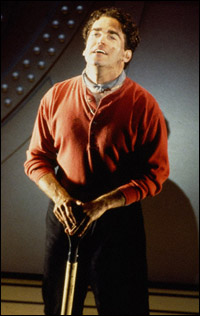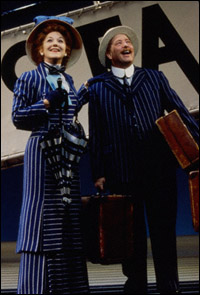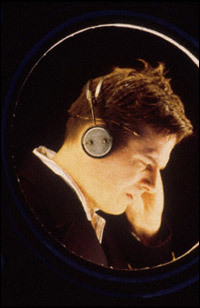
As the original ad campaign for Titanic mused, the ship of dreams set sail from Southampton, England, on April 10, 1912, and in spring of 1997, she finally arrived in New York.
The massive production, with a large ensemble cast that included Michael Cerveris, Victoria Clark, Brian d'Arcy James and Martin Moran, also faced some troubled waters on its course toward opening night.
As Yeston recalled with a laugh, "Nobody could get the set to work. We lost our record for worst preview period in Broadway history when Spider-Man came along. I'm sorry for them, but boy have I been there." Despite regular reporting in the press of Titanic's choppy preview process (and its multi-tiered hydraulic set), the musical opened to strong critical notices at the Lunt-Fontanne Theatre, and later earned the Tony Awards for Best Book (Peter Stone), Best Score, Best Orchestrations (Jonathan Tunick), Best Scenic Design (Stewart Laing) and Best Musical.
"It's unbelievable that it's now 15 years," Yeston said looking back. "I was always fascinated by the story of the Titanic growing up. But Titanic, as you become older and you start to think about things, was one of the great myths or stories of the 20th Century that stuck in my mind. In 1985 when Robert Ballard found the Titanic, I began thinking from a historical and intellectual point of view, 'Wow, this really is one of the primary stories of the 20th century.'"
 |
||
| Brian d'Arcy James in Titanic. |
||
| photo by Joan Marcus |
From the start, the two collaborators knew they did not want to force a fictional love story to be set against the sinking of the Titanic. Their tale would focus on the stories of actual passengers and crew on the ship. "We did not want 'The Love Boat,'" Yeston laughed.
Titanic's musical narrative is laid out in groups of three characters. The story of the ship itself is told through the architect, the owner and the captain. "For me, the architect was the 'composer'; he was the creator of the ship, the spirit of creativity and the great dream of progress. So, that would tell the story of why things happen and whose fault it may have been," Yeston stated.
The following group is a trio who were important in the witnessing of the disaster, according to Yeston, "the Stoker, who was down below and knew they were going too fast; the look-out who knew that it was too dark and you couldn't see any froth up against the icebergs; and the telegraph operator, who was witness to why ships could not come soon enough."
Finally, there are the three Kates, the Irish immigrants who carry the hopes and dreams of the third-class passengers who long for an abundant life in a new world. From there, a series of other notable figures from the era, including John Jacob Astor and Isidor and Ida Strauss, thread through the narrative.
 |
||
| Victoria Clark and Bill Buell |
||
| Photo by Joan Marcus |
According to Yeston, "It is a profound warning story, and shortly after Ballard found the Titanic, the [Challenger] blew up, because of an O-Ring, and that is when it really cemented in my mind, that this is a lesson we keep on learning. The Titanic was built to save lives – the idea was that the ship would be its own lifeboat."
He continued, "Our dreams are counterbalanced by our dreams and our failures, but as tragic as it is, this is a story of a ship that carried the dreams of a whole world, and we conceived of the show in that way."
Since its lavish Broadway outing, Titanic has been staged to much simpler effect in schools, community and regional theatres across the country and throughout the world. Over 71 productions of Titanic are currently scheduled for performance this year, many of which are staged to commemorate the centennial of the ship's maiden voyage and the tragedy.
Perhaps the most poignant of these productions is currently playing Belfast, Ireland, where Titanic was built. The Belfast Operatic Company first staged Titanic in 2005 and is remounting the production for the 100th anniversary at the Grand Opera House. Performances began April 10, the day Titanic first set sail, and the run will conclude with a special 11:40 PM curtain on April 14. The time marks the exact moment the ship struck the iceberg. It took just under three hours for the luxury liner to sink, which is almost the running-time of the musical. The cast will sing the final "Godspeed Titanic" in the early morning hours of April 15, the date of the ship's sinking.
 |
||
| Martin Moran |
||
| photo by Joan Marcus |
The city has also just opened Titanic Belfast, a new state-of-the-art museum documenting the history of the great ship.
Yeston credits the musical's continued success in its ability to deliver audiences an emotionally compelling story that challenges their expectations of what they project will happen. But, as Stone also pointed out to Yeston, "It's one of those rare moments in history which has a beginning, middle and end."
"We start off with the Stoker coming out and kissing his girlfriend goodbye, saying, 'I'll see ya in two weeks,' as he sings, 'Fare thee well my darlin', I'll be back before a fortnight has passed.' So, the audience thinks they know the story, but from that point on, all best are off," he said.
"The reaction to what was happening to the Titanic was a perfectly human sequence of denial, followed by anger, followed by bargaining, followed by acceptance. But in every step along the way, the people are optimistic and will not accept the obvious tragedy that is befalling them, which is the essence of musical theatre. The show fights against expectation and underlines hope and dreams."



Matthew-Murphy.jpg)






